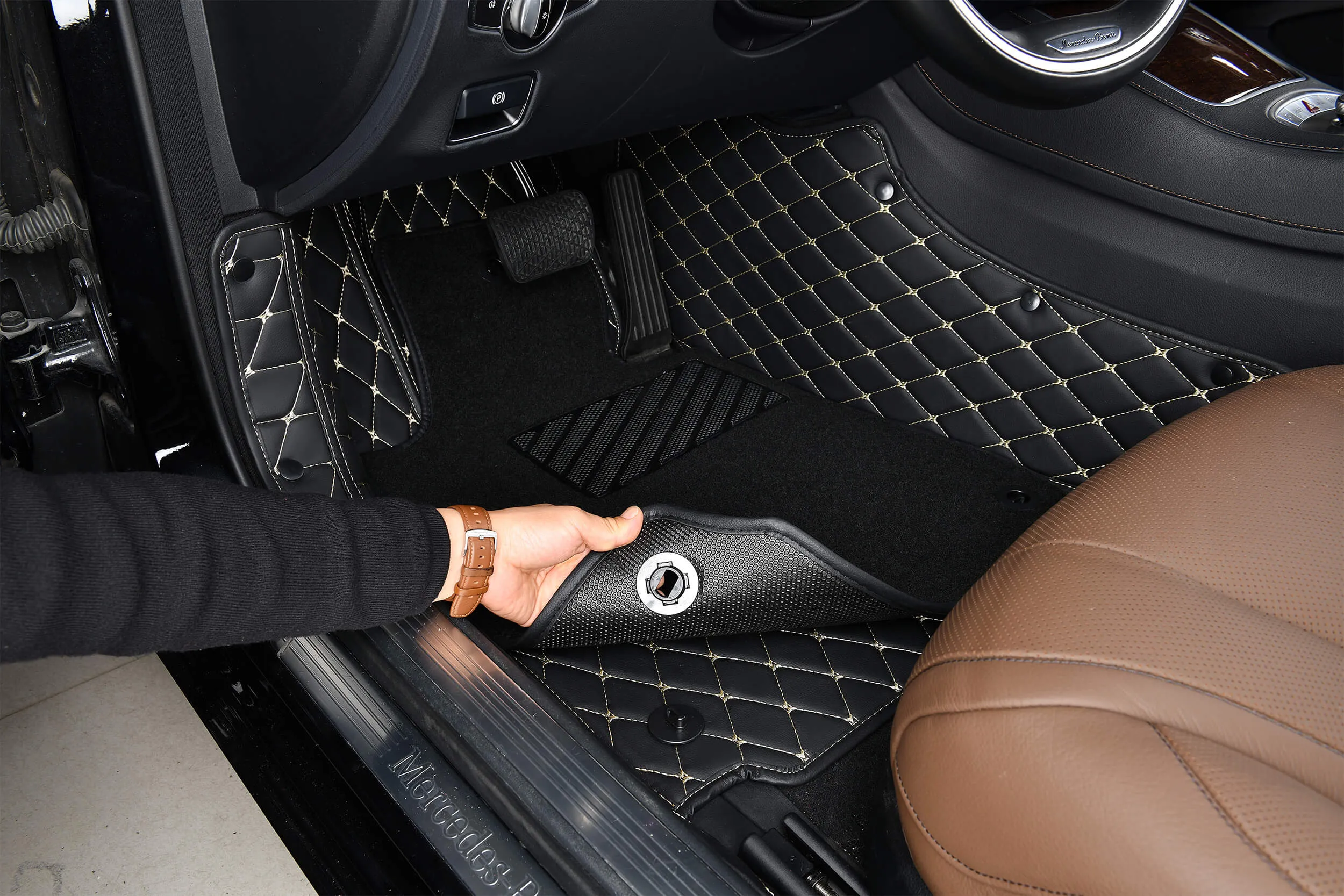When it comes to selecting car mats, drivers are often presented with a myriad of options, each boasting unique materials and features. These mats play a vital role in protecting the vehicle’s interior from dirt, moisture, and wear and tear, making them an essential accessory for any car owner.
In this article, we’ll take a closer look at three popular materials used in car mat manufacturing: rubber mats, carpeted mats, and all-weather mats. Through in-depth research, we’ll uncover the advantages, disadvantages, and key considerations associated with each material, helping you make an informed decision when choosing the right car mats for your vehicle.
Rubber Mats: Durable and Practical
Rubber mats are renowned for their durability and practicality, making them a popular choice among drivers seeking reliable protection for their vehicle’s floor. These mats are typically crafted from high-quality rubber compounds, such as natural rubber or synthetic rubber blends, engineered to withstand heavy use and harsh conditions.
Advantages of Rubber Mats
- Durability: Rubber mats are exceptionally resilient, capable of enduring frequent foot traffic, spills, and debris without showing signs of wear and tear. The robust nature of rubber makes these mats ideal for drivers who lead active lifestyles or frequently transport cargo that may soil the vehicle’s interior.
- Easy Maintenance: One of the standout features of rubber mats is their effortless maintenance. Unlike carpeted mats, which may require vacuuming and spot cleaning, rubber mats can be quickly rinsed off with water or wiped clean with a damp cloth, making them a convenient option for busy drivers.
- Affordability: Rubber mats are often more budget-friendly than their carpeted counterparts, making them an attractive option for cost-conscious consumers. Whether you’re purchasing a set of universal mats or custom-fit mats tailored to your vehicle’s specifications, rubber mats offer excellent value for money.
Disadvantages of Rubber Mats
- Aesthetic Appeal: While rubber mats excel in terms of durability and functionality, they may lack the aesthetic appeal of carpeted mats. Some drivers prefer the plush look and feel of carpeting, finding rubber mats to be less visually appealing in comparison.
- Comfort: Although rubber mats provide excellent protection against dirt and moisture, they may not offer the same level of comfort underfoot as carpeted mats. The firm texture of rubber can feel less cushioned, particularly on long drives, which may be a consideration for drivers prioritising comfort.
- Slippery When Wet: Another potential drawback of rubber mats is their tendency to become slippery when wet. This can pose a safety hazard for drivers and passengers, especially during rainy or snowy weather conditions. To mitigate this risk, some rubber mats feature anti-slip backing or textured surfaces for improved traction.
Carpeted Mats: Luxurious and Stylish
Carpeted mats add a touch of luxury and sophistication to the interior of a vehicle, elevating its aesthetic appeal while providing comfort and insulation for occupants. These mats are typically crafted from plush carpeting materials, such as nylon or polypropylene, chosen for their softness and durability.
Advantages of Carpeted Mats
- Luxurious Appearance: One of the primary advantages of carpeted mats is their luxurious appearance. The soft, plush texture of the carpeting adds warmth and elegance to the vehicle’s interior, enhancing its overall aesthetic appeal.
- Comfort: Carpeted mats offer superior comfort underfoot compared to rubber mats, thanks to their soft and cushioned surface. This makes them particularly well-suited for drivers and passengers who appreciate a more comfortable driving experience, especially during long journeys.
- Effective Dirt Trapping: Despite their softness, carpeted mats are adept at trapping dirt, debris, and moisture within their fibres. The dense pile acts as miniature bristles, capturing particles and preventing them from spreading throughout the vehicle’s interior, thus helping to maintain cleanliness.
Disadvantages of Carpeted Mats
- Maintenance Challenges: One of the main drawbacks of carpeted mats is the maintenance challenges they present. Unlike rubber mats, which can be easily wiped clean, carpeted mats require more extensive care and maintenance, including regular vacuuming and spot cleaning to remove dirt and stains effectively.
- Prone to Wear and Tear: Over time, carpeted mats may be more prone to wear and tear compared to rubber mats, particularly in high-traffic areas such as the driver’s side footwell. Constant friction from shoes and debris can cause the carpet fibres to become matted or worn, detracting from their appearance and longevity.
- Stain Susceptibility: Carpeted mats are susceptible to staining, especially from spills or liquids that penetrate the carpet fibres. While some mats may feature stain-resistant treatments or waterproof backings to mitigate this risk, drivers should be vigilant about promptly cleaning up spills to prevent permanent damage.
All-Weather Mats: Versatile and Durable
All-weather mats are designed to withstand the rigours of various weather conditions and provide maximum protection for the vehicle’s interior against dirt, moisture, and debris.
These mats are typically constructed from heavy-duty materials, such as rubber, thermoplastic elastomers (TPE), or vinyl, chosen for their resilience and durability.
Advantages of All-Weather Mats
- Extreme Durability: All-weather mats are engineered for maximum durability, capable of withstanding extreme temperatures, UV exposure, and moisture without deteriorating. This makes them an excellent choice for drivers who frequently encounter harsh weather conditions or engage in outdoor activities.
- Versatility: Unlike rubber or carpeted mats, which may be better suited for specific seasons or conditions, all-weather mats are versatile enough to provide year-round protection. Whether it’s rain, snow, mud, or sand, these mats can handle it all, ensuring that your vehicle’s interior remains clean and pristine.
- Easy Maintenance: Similar to rubber mats, all-weather mats boast easy maintenance requirements. They can be quickly rinsed off with water or wiped clean with a damp cloth, making them an ideal option for drivers with busy lifestyles or those who frequently transport pets or messy cargo.
Disadvantages of All-Weather Mats
- Visual Appeal: While all-weather mats excel in terms of functionality and durability, they may lack the luxurious appearance of carpeted mats. Some drivers may find the utilitarian design of these mats to be less visually appealing, particularly in vehicles with premium interiors.
- Price Point: Premium all-weather mats crafted from high-quality materials can be more expensive than standard rubber mats or carpeted mats. While many drivers consider the added durability and protection to be worth the investment, cost-conscious consumers may find the higher price point prohibitive.
- Less Cushioning: Although all-weather mats provide excellent protection against dirt and moisture, they may offer less cushioning and comfort underfoot compared to carpeted mats. Drivers who prioritise comfort may find the firm texture of these mats to be less supportive, especially on long drives.
Conclusion: Choosing the Right Car Mats for Your Needs
Selecting the right car mats for your vehicle or custom car mats from the UK is a decision that requires careful consideration of your individual needs, preferences, and budget. Whether you prioritize durability, comfort, or all-weather protection, each type of car mat offers its own unique set of advantages and disadvantages.
For drivers seeking durability and practicality, rubber mats are an excellent choice, offering easy maintenance and reliable protection against dirt and moisture
Those who value luxury and comfort may prefer carpeted mats, which provide a plush feel and elegant appearance but require more extensive maintenance. For versatile protection in all weather conditions, all-weather mats are the go-to option, offering extreme durability and easy maintenance, albeit with a potentially higher price tag.
Ultimately, the best car mats for you will depend on your specific requirements and preferences. By considering the pros and cons of each material and weighing them against your needs, you can make an informed decision that enhances the comfort, appearance, and longevity of your vehicle’s interior.
Remember, whether you opt for the rugged durability of rubber mats, the plush comfort of carpeted mats, or the all-weather versatility of all-weather mats, investing in quality car mats is essential for maintaining your vehicle’s interior and preserving its value over time.



